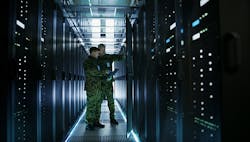Naval aviation asks industry for research in artificial intelligence (AI), cyber, and hypersonic technologies
PATUXENT RIVER NAS, Md. – Artificial intelligence (AI), cyber warfare, quantum computing, hypersonics, electronic warfare (EW), avionics, and secure communications are only a few of the topics in a new U.S. naval aviation research initiative.
Officials of the Naval Air Warfare Center Aircraft Division (NAWCAD) at Patuxent River Naval Air Station, Md., released an officewide research solicitation on Thursday (N00421-21-S-0001) for research topics that also include avionics, sensors and electronic warfare; aeromechanics; power and propulsion systems; systems engineering; data science and visualization; and warfare analysis.
The FY21 Naval Air Warfare Center Aircraft Division (NAWCAD) Office-Wide Broad Agency Announcement will be open for one year, and involves whitepaper submissions and invitations for a select number of companies to submit formal proposals who previously offered promising white papers.
The 17 research topics involved in this solicitation are:
-- AI and machine learning, which involves autonomous system development, testing, evaluation, verification and validation tools, collaborative autonomy, complex reasoning, agent based decision making, deep reinforcement learning, neural networks, and demand forecasting;
Related: Top technology challenges this decade for the warfighter
-- data science and visualization, which involves predictive modeling algorithms, complex big-data environments, data access, storage and retrieval, data visualization techniques, and statistical analysis;
-- cyber, which involves cyber effects modeling, reverse engineering, applied cryptology, behavioral analysis, intrusion, adaptive cybersecurity, simulation and interface research, concolic testing and systems configuration management;
-- quantum, which involves secure communication and sensing capabilities, nitrogen vacancy diamond sensing, quantum encryption, and quantum computing;
-- hypersonic systems, which involves testing and evaluation, high temperature and specific strength materials and structures, propulsion, and multidiscipline, high-fidelity modeling and simulation;
-- test and evaluation engineering, which involves telemetry, communications, data links and data acquisition, signature technologies, mission system testing, system of systems testing environments, virtual reality (VR), augmented reality (AR), extended reality (XR), target engineering, airborne threat simulation, integrated battle-space simulation (Live Virtual Constructive Environments), hardware-in-the-loop testing, flight instrumentation, ground radar analysis, test article configuration, navigation, and identification, manned-unmanned teaming, advance training systems to include instructional techniques and strategies, and game-based training;
-- avionics, sensors and EW, which involves passive/active sensor systems (RF, EO/IR, and acoustic), advanced/alternative precision navigation and timing (PNT), advanced computational/open system architectures, advanced signal and image processing, flight information and control systems, and advanced concepts in electronic warfare systems;
-- secure communications and networks, which involves resilient data and communications networks for Command and Control, platform/system health monitoring, effective data transfer of both communications and video, all with consideration for autonomous applications, while performing in dynamic and contested environments;
-- warfare analysis, which involves operational suitability, signal extraction, clutter reduction, modeling and simulation, maritime effectiveness, vulnerability and capability based assessment, and conceptual aircraft design;
-- readiness and sustainment, which involves automated sustainment environment, diagnostics and prognostics, predictive maintenance, digital thread integration, logistics modeling and simulation, and condition based maintenance improvements;
-- materials and aircraft structures, which involves additive manufacturing, corrosion prevention, non-destructive inspection, metals and ceramics, polymers and composites, analysis and simulation of aircraft structures, structural mechanics, and life management of airframes;
-- aeromechanics, which involves aerodynamic and flight controls (manned and unmanned), aeromechanics modeling and analysis tools, flight performance, rotorcraft aerodynamics and performance, ship/aircraft aerodynamic interactions, and unmanned aviation and integration including pilot augmentation and automation and UAV autonomous landing flight mechanics;
-- mechanical systems, which involves fire and ice protection, fuel containment, hydraulic systems, pneumatic systems and landing gear systems analysis;
-- power and propulsion systems, which involves reliability engineering, fuel systems, prognostics and diagnostics, energy storage/efficiency, air-breathing engines, fuels and lubricants, electrical power generation, auxiliary power, low observable signature technologies, propulsion life management, and mechanical and drive systems;
-- human systems, which involves human performance assessment and modeling, cognitive performance/workload, human-machine interface/teaming, protective equipment, controls and displays, ergonomics, anthropomorphic measurement, virtual environments, and human factor engineering (social, behavioral, health, and cultural);
-- support equipment, which involves launch and recovery equipment, electro-magnetics, high-energy generation and control, environmental sensing, prognostics and health monitoring, automatic testing of hardware and software, displays, advanced maintenance technologies, information systems and intelligent agents, and advanced computer and data processing applications; and
-- systems engineering, which involves integrated modeling environments, model based systems engineering methodology, integration of system models and physics-based models, systems safety engineering, air platform development and integration, system of systems architectures, aviation/ship integration, combat survivability, reliability and maintainability engineering, anti-tamper engineering, electromagnetic environmental effects engineering, manufacturing and cost analysis. NAWCAD may also consider submissions outside these areas if the white paper involves the development of novel-based capabilities with potential to enhance naval capabilities.
Companies interested should email three-page white papers no later than 2 June 2022 to the Navy at [email protected], with N00421-21-S-0001 in the subject line.
More information is online at https://sam.gov/opp/3a0e0f16bedb42db830347d2c18fc9e9/view.
About the Author
John Keller
Editor-in-Chief
John Keller is the Editor-in-Chief, Military & Aerospace Electronics Magazine--provides extensive coverage and analysis of enabling electronics and optoelectronic technologies in military, space and commercial aviation applications. John has been a member of the Military & Aerospace Electronics staff since 1989 and chief editor since 1995.
